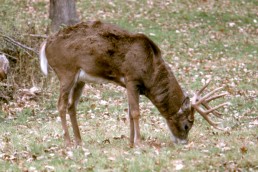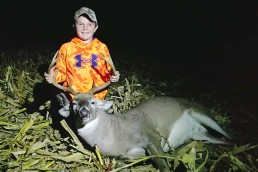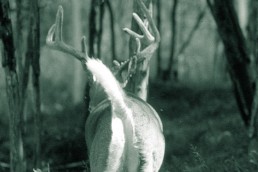SHARE THIS POST
When a desirable quarry, especially a big buck, unexpectedly appears a short distance away, goofing up somehow is not uncommon for even the most seasoned whitetail hunter. Sometimes a mere telltale sound will spoil a hunter’s chance for an easy shot. Often, it’s a movement made while raising a rifle or bow that’s quickly spotted by the motion-sensitive eyes of a mature whitetail. During such dread-filled moments, it’s difficult to anticipate when a quarry’s eyes will remain hidden by intervening cover or a turned-away head long enough to complete the moves necessary before firing without being seen by the deer.
One unrealized ally while this is happening is a whitetail’s tail.
This feeding buck with its tail down is just completing a quick side-to-side swish of its tail—no white hairs of tail or rump erect. This means it believes “all is well,” and it doesn’t realize you’re near and it is about to take a step forward and/or raise its head. A deer feeding in deep vegetation with its head down, completely hidden, is as vulnerable as a whitetail can be. However, be ready to freeze if you’re not yet ready to fire the moment you see its tail swish from side to side.
A deer standing frozen with its tail slightly or fully raised with white hairs of tail and rump slightly erect means it’s unsure something potentially dangerous is near. It does not know where it is or whether it’s actually dangerous. If it hears nothing and sees nothing, move during the next 5 to 15 minutes, as it will likely settle down and resume whatever it was doing earlier, greatly improving your odds for an easy shot
This buck heard or glimpsed something approaching that may or may not be dangerous. To be safe, it is cantering away (not as fast as bounding) with its tail up and wagging loosely from side to side, with white hairs of tail and rump not erect or fanned. This means the buck is not greatly alarmed and will probably halt within 100 yards to resume whatever it was doing earlier. Since 2000, I have successfully stalked and taken two tail-wagging bucks where they were feeding 100 yards away or nearer 15 to 30 minutes later.
Are you enjoying this post?
You can be among the first to get the latest info on where to go, what to use and how to use it!
This buck definitely knew a hunter was near and was ready to flee, but it didn’t know where the hunter was. The buck was moving nervously from side to side, sometimes halting to stomp a fore-hoof and snorting once. Its tail was alternately half to fully raised and white hairs of its tail and rump were erect and fully fanned, meaning the buck was greatly alarmed. Once underway, a buck in this state is unlikely to halt until well off-range, where it will probably remain for the rest of the hunting season. Be ready to raise your bow or rifle quickly the first moment the buck’s eyes are hidden from your view. A doe that bounds away with its tail fully raised and its white hairs of tail and rump are fully erect and fanned, means it’s also heading off-range, unlikely to return for four or more days.
A wounded whitetail (this buck was injured in a battle with another buck) will generally bound, canter, trot or walk away with its tail down and firmly tucked against its rear. This is a sign of a hit.
Upon discovering a nearby hunter, many older bucks will deliberately avoid attracting the hunter’s attention by raising their tails and bounding noisily away. Or, instead, they’ll sneak silently away through dense cover, tail down. A buck reacting in this manner will not usually abandon its range. At a different, new and unused stand site 100 yards or more away, a skilled stand-hunter may soon see that buck again.
An unhurried doe with its tail held halfway up and to one side, with no white hairs of tail or rump erect (perhaps occasionally bleating like a lamb as it passes), is likely in heat. Take care not to alarm this best-of-all-buck lures. A mature buck may be on its trail, though showing up as much as an hour later.
MWO
SHARE THIS POST
Did you enjoy this post?
You can be among the first to get the latest info on where to go, what to use and how to use it!
MWO
We believe being outdoors is good. With more than 1,000 articles each year, MidWest Outdoors magazine is all about sharing outdoor experiences with you—where to go, what to use and how to use it… whether you’re close to home or on that trip of a lifetime.



